Cash flow statement
The cash flow statement is the name commonly used by practicing accountants for the statement of cash flows or SCF. We will use these names interchangeably throughout our explanation, practice quiz, and other materials.
The cash flow statement is required for a complete set of financial statements.
The SCF reports the cash inflows and cash outflows that occurred during the same time interval as the income statement. The time interval (period of time) covered in the SCF is shown in its heading. Two examples include "Year ended December 31, 2020" and "Three months ended September 30, 2020".
The amounts on the SCF provide the reasons for the change in a company's cash and cash equivalents during the period covered. For simplicity, we will assume that the company does not have cash equivalents. Therefore, our SCF will explain the change in the company's cash from the beginning of the year to the end of the year (or the beginning of the quarter to the end of the quarter, etc.). Given our assumption that the company does not have cash equivalents, the following is a skeleton of the SCF's format:
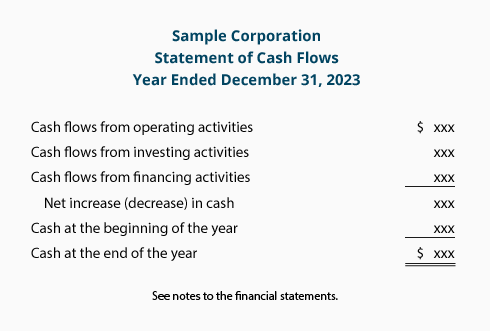
The cash flows from operating activities section provides information on the cash flows from the company's operations (buying and selling of goods, providing services, etc.). With the most likely used indirect method, the starting point of this section is the company's net income. It is followed with adjustments to convert the amount of net income from the accrual method to the cash amount.
The cash flows from investing activities lists the cash flows associated with the purchase and sale of noncurrent (long-term) assets such as investments and property, plant and equipment.
The cash flows from financing activities section reports the cash flows associated with the issuance and repurchase of a corporation's bonds and capital stock, the payment of dividends, and the borrowing and repayment of short-term and long-term loans.
At the bottom of the SCF (and other financial statements) is a reference to inform the readers that the notes to the financial statements should be considered as part of the financial statements. The notes provide additional information such as disclosures of significant exchanges of items that did not involve cash, the amount paid for income taxes, and the amount paid for interest.
We begin with reasons why the statement of cash flows (SCF, cash flow statement) is a required financial statement.
Why the Cash Flow Statement is Required
The accounting profession realizes that reading only one or two financial statements is not sufficient for understanding a company's finances and operations. Accordingly, the generally accepted accounting principles (GAAP, US GAAP) require that the statement of cash flows be part of a set of financial statements distributed outside of a company. A complete set of financial statements consists of five financial statements and the notes to the financial statements:
- Income statement
- Statement of comprehensive income
- Balance sheet
- Statement of stockholders' equity
- Statement of cash flows
- Notes to the financial statements
While the income statement amounts make the news, the amounts are based on the accrual basis of accounting. This method of accounting best measures a company's sales, expenses, and earnings during a short time interval. However, the income statement does not measure and report the amounts of cash that flowed in and out of the company. For example, the income statement does not report the following:
- Cash collected from sales. (The cash might be collected from customers 45 days after the sale.)
- Cash paid for goods sold. (Payment may have been made many months prior to their sale.)
- Cash paid for buildings and equipment that will be expensed over the next 5 to 30 years.
- Cash received from the sale of long-term assets
- Cash received from bank loans
- Cash payments to reduce a loan's principal balance
- Cash withdrawn by owners or cash dividends paid to stockholders
A company's understanding of its cash inflows and outflows is critical for meeting its short-term and long-term obligations to its suppliers, employees, and lenders. Current and potential lenders and investors are also interested in the company's cash flows.
Financial analysts will review closely the first section of the cash flow statement, cash flows from operating activities. Part of the review consists of comparing this section's total (described as net cash provided by operating activities) to the company's net income. This is done to see whether the revenues, expenses, and net income reported on the income statement are consistent with the change in the company's cash balance.
If they are not consistent, they will seek to uncover the root causes for the differences. Perhaps the company's inventory is no longer in demand or is being returned by customers. Perhaps receivables are not being collected, and so on. (In short, the analyst believes that "Cash is king". While there can be some leeway in applying accounting principles, there is no leeway when it comes to reporting the amount of cash.)
Lastly, the SCF provides the cash amounts needed in some financial models.
Example of a Cash Flow Statement
The following is an example of the statement of cash flows, which is commonly referred to as the cash flow statement or SCF. (The company and the amounts shown are hypothetical.)
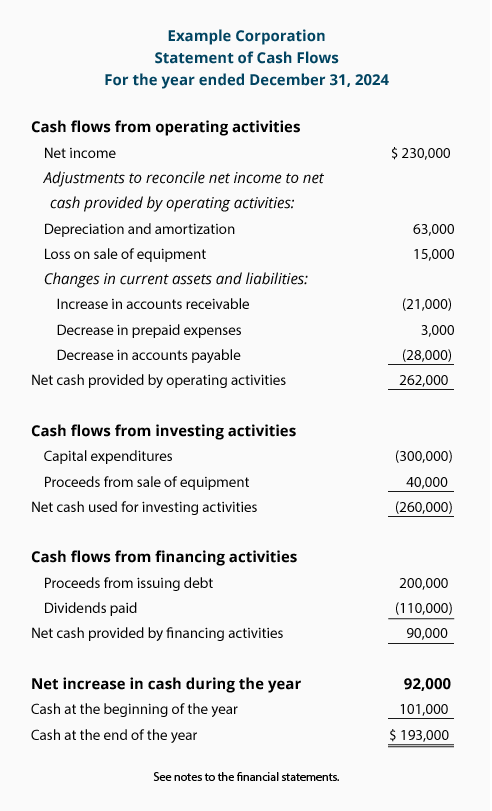
The heading for Example Corporation's statement of cash flows indicates that the amounts occurred during the year January 1 through December 31, 2020.
In bold font you see subheadings for the three sections of the SCF. Many corporations omit "Cash flows from" and simply show the following as the subheadings:
- Operating activities
- Investing activities
- Financing activities
Some amounts are shown in parentheses, while other amounts are not. We will cover these in detail later, but let's introduce the technique by looking at the amounts shown for investing activities:
The amount (300,000) communicates that cash of $300,000 was paid out, was a cash outflow, or that it reduced the company's cash balance. Parentheses can also be thought of as having a negative or unfavorable effect on the company's cash balance.
The amount 40,000 indicates that cash of $40,000 was received, was a cash inflow, or that it increased the company's cash balance. Amounts without parentheses can also be thought of as having a positive or favorable effect on the company's cash balance.
The (260,000) is described as the net cash used for investing activities. "Net" means the combination of the cash inflow of (300,000) and the cash outflow of 40,000.
The amount 92,000 shown on the line Net increase in cash during the year is the combination of each section's sum: 262,000 + (260,000) + 90,000. Since this net amount or grand total is a positive amount, it is shown without parentheses and is described as net increase in cash during the year.
Note that the net increase (or net decrease) in cash during the year is combined with the cash at the beginning of the year to show the cash at the end of the year. In our example, it is 92,000 + 101,000 = $193,000. The end of the year balance of $193,000 should agree with the cash balance on the company's balance sheet for December 31, 2020.
Cash Flows from Operating Activities
The first section of the statement of cash flows is described as cash flows from operating activities or shortened to operating activities. Operating activities are also referred to as company operations.
Operating activities are the business activities other than the investing and financial activities.
Here is the operating activities section of Example Corporation's SCF which we will be referring to in our discussion:
Note that the combination of the positive and negative amounts in this section add up to a positive 262,000. Hence, it is described as "Net cash provided by operating activities". If the amounts had added up to a negative amount, the description would be "Net cash used by operating activities".
Indirect Method for Preparing the Cash Flow Statement
Companies may choose to use either the direct method or the indirect method when preparing the SCF section cash flows from operating activities. However, the indirect method is the dominant method used and the one we will explain.
Under the indirect method, the SCF section cash flows from operating activities begins with the amount of net income, which is taken from the company's income statement. Since the net income was based on the accrual method of accounting, the amount of net income must be adjusted to the cash amount.
If an adjustment to the amount of net income is in parentheses, it is subtracted from net income. It indicates that the cash amount was less than the related amount on the income statement. Adjustments in parentheses can also be interpreted to be unfavorable for the company's cash balance.
An adjustment to net income that is not in parentheses is a positive amount, which indicates the cash amount was more than the related amount on the income statement. A positive adjustment can also be interpreted to be favorable for the company's cash balance.
Adjustments to Convert the Net Income Amount to the Cash Amount
In the case of Example Corporation, the section cash flows from operating income begins with the company's net income for the year: $230,000.
A large corporation often has 10 or more adjustments to convert the amount of net income to the amount of cash. However, we will limit our discussion to some of the more common adjustments shown on Example Corporation's statement of cash flows:
Depreciation and amortization 63,000. Since this adjustment amount appears without parentheses, it indicates that the cash amount will be $63,000 more than the amount of net income. The reason is depreciation and amortization expense reduced the company's net income, but it did not reduce the company's cash balance. In other words, without this noncash expense of $63,000, the company would have seen its cash increase by $230,000 + $63,000.
Loss on sale of equipment 15,000. This amount appears without parentheses and therefore the company's cash amount will be more than the net income. The reason is that Example Corporation's net income had been reduced by this loss of $15,000. However, the company did not pay out the $15,000. Therefore, it is added to the amount of net income, causing the cash from operations to be greater by $15,000. (If cash is received from the sale of this noncurrent asset, the amount received is reported as a positive amount on the SCF in the section cash flows from investing activities.)
If there was a gain on the sale of a noncurrent asset, the amount of the gain would have increased net income. However, since the entire amount of cash received from the sale of a noncurrent asset is reported under cash flows from investing activities, the gain is subtracted from the amount of net income.
Increase in accounts receivable (21,000). Since this amount is in parentheses, it communicates that the company collected less cash than the amount of sales reported on the income statement. This is determined by examining how the balance in accounts receivable changed during the year. If the company's receivables increased, it indicates that not all sales on the income statement were collected. This is viewed as unfavorable for the company's cash balance. Therefore, the amount of the increase in accounts receivable is deducted from the amount of net income.
If the balance in the company's accounts receivable had decreased, it indicates that the company collected more than the amount of sales reported on the income statement. Therefore, the amount of the decrease in receivables would be added to the amount of net income. The decrease in receivables is positive, favorable, and good for the company's cash balance.
Decrease in prepaid expenses 3,000. If the balance in the current asset prepaid expenses had decreased, it meant that $3,000 of the amount of expenses on the income statement did not require using $3,000 of cash. Therefore, we add $3,000 to the amount of net income. In other words, using part of the prepaid amount instead of paying cash was favorable/positive for the company's cash balance.
If the balance in prepaid expenses had increased during the year, it means the company had paid out more cash than the amount reported as expense on the income statement. Therefore, the increase in this current asset is subtracted from the amount of net income. In other words, increasing the balance in prepaid expense was not good for the company's cash balance.
Decrease in accounts payable (28,000). If the balance in the current liability accounts payable had decreased, it indicates that the company paid its suppliers more than the amount of expenses reported on the income statement. As a result, the decrease in payables is shown in parentheses. Paying the suppliers more than the related expenses reported on the income statement had a negative or unfavorable effect on the company's cash balance.
If the balance in accounts payable had increased, it would indicate the company paid its suppliers less than the expenses reported on the income statement. Paying out less cash is good/favorable for the company's cash balance. Therefore, an increase in payables is added to the amount of net income.
Quick Guide to Changes in Current Asset Balances
When adjusting a company's net income for changes in the balances of the current assets, the following may be a helpful guide:
If a current asset's balance (other than cash) had increased, the amount of the increase is subtracted from the amount of net income. The increase in a current asset (other than cash) had a negative/unfavorable effect on the company's cash balance.
If a current asset's balance (other than cash) had decreased, the amount of the decrease is added to the amount of net income. The decrease in a current asset (other than cash) had a positive/favorable effect on the company's cash balance.
Quick Guide to Changes in Current Liability Balances
When adjusting a company's net income for changes in the balances of the current liabilities, the following may be a helpful guide:
If a current liability's balance (other than loans payable) had increased, the amount of the increase is added to the amount of net income. The increase in a current liability had a positive/favorable effect on the company's cash balance.
If a current liability's balance (other than loans payable) had decreased, the amount of the decrease is subtracted from the amount of net income. The decrease in a current liability had a negative/unfavorable effect on the company's cash balance.
The adjustments reported in the operating activities section will be demonstrated in detail in "A Story To Illustrate How Specific Transactions and Account Balances Affect the Cash Flow Statement" in Part 3.
Next, we will discuss the cash flows involving a company's investing activities.
Cash Flows from Investing Activities
The investing activities section of the SCF reports the cash inflows and cash outflows related to the changes that occurred in the noncurrent (long-term) assets section of the balance sheet.
Examples of investing activities include the following:
- Capital expenditures (additions to property, plant and equipment)
- Proceeds from the sale of property, plant and equipment
- Purchase of long-term investments
- Proceeds from the sale of long-term investments
Our discussion uses Example Corporation's cash flows from investing activities:
Capital expenditures are the amounts spent for acquiring, adding, and/or improving noncurrent assets used in a business. (Large amounts spent for repairing an existing asset are reported as expenses on the current period's income statement.)
Since the amount spent by Example Corporation for capital expenditures required an outflow of cash, the amount appears in parentheses: (300,000). You can also think of the amount spent as unfavorable for the company's cash balance and/or cash used.
Proceeds from sale of equipment 40,000 is a positive amount since this is the amount of cash that was received. In other words, the $40,000 was an inflow of cash and therefore favorable for Example Corporation's cash balance.
(Also see our discussion of Cash Flows from Operating Activities for the reporting of the gains and losses on the sale of noncurrent assets.)
Amounts spent to acquire long-term investments are reported in parentheses, since it required an outflow or use of cash.
The proceeds (cash received) from the sale of long-term investments are reported as positive amounts since the proceeds are favorable for the company's cash balance.
Cash Flows from Financing Activities
The cash inflows and outflows from financing activities are related to the changes in the following balance sheet sections:
- Noncurrent (long-term) liabilities
- Stockholders' equity (or owner's equity)
- Loans and similar debt reported under current liabilities
Examples of the descriptions and amounts typically reported under cash flows from financing activities include the following:
- Proceeds from long-term debt
- Repayment of long-term debt
- Proceeds from issuing capital stock
- Payment of dividends
- Purchase of treasury stock
- Change in short-term debt
Our discussion of financing activities will use the following section of Example Corporation's SCF:
Assume that Example Corporation issued a long-term note/loan payable that will come due in three years and received $200,000. As a result, the amount of the company's long-term liabilities increased, as did its cash balance. Therefore, this inflow of $200,000 is reported as a positive amount in the financing activities section of the SCF.
Next, assume that Example Corporation distributed $110,000 of cash dividends to its stockholders. The $110,000 cash outflow has an unfavorable or negative effect on the company's cash balance. As a result, the amount will be shown in the financing section of the SCF as (110,000).
When Example Corporation repays its loan, the amount of the principal repayment will appear in parenthesis (since it will be an outflow of cash).
If Example Corporation issues additional shares of its common stock, the amount received will be reported as a positive amount.
Reconciling the Increase in Cash from the SCF with the Change in Cash Reported on the Balance Sheet
The three net cash amounts from the operating, investing, and financing activities are combined into the amount often described as net increase (or decrease) in cash during the year.
In Example Corporation the net increase in cash during the year is $92,000 which is the sum of $262,000 + $(260,000) + $90,000.
As was shown in the Example Corporation's SCF the net increase for the year was added to the beginning cash balance to arrive at the ending cash balance.
The ending cash balance should agree with the amount reported as cash on the company's December 31, 2020 balance sheet.
Supplemental Information
Since all transactions cannot be adequately communicated through the relatively few amounts reported on the financial statements, companies are required to have notes to the financial statements.
Some required information for the SCF that will be disclosed in the notes includes significant exchanges that did not involve cash, the amount of interest paid, and the amount of income taxes paid.
A Story To Illustrate How Specific Transactions and Account Balances Affect the Cash Flow Statement
The remainder of our SCF explanation illustrates how specific transactions and account balances affect a company's cash flow satement (as well as its income statement and balance sheet).
We will use an easy-to-follow story with only one transaction per day to help you better understand the cash flow statement. You will also see how the financial statements are connected.
Matt is a college student who enjoys buying and selling merchandise using the Internet. On January 2, 2020, he decided to turn his hobby into a business called "Good Deal Co." Each month the Good Deal Co. had one or two transactions. Matt wants to prepare an income statement, balance sheet, and a statement of cash flows for the current month and for the year-to-date period. He asks our help in preparing and understanding the SCF.
January Transactions and Financial Statements
On January 2, 2020 Matt invested $2,000 of his personal money into his sole proprietorship, Good Deal Co. On January 20, Good Deal buys 14 graphing calculators at a cost of $50 per calculator (which was about 50% of the selling price Matt has observed at the retail stores). The total cost to Good Deal for all 14 calculators was $700. Good Deal had no other transactions during January.
Matt prepared the income statement and balance sheet for his new business as of January 31, 2020 as shown below:
Note that the $50 cost of each calculator is not reported on the income statement as an expense until a sale occurs. (This is part of the accrual basis of accounting and the related matching principle.)
The cost of each unsold calculator will be reported as the asset inventory on the company's balance sheet. Therefore, the 14 calculators purchased at $50 each will appear as $700 of inventory. The company's balance sheet will report the remaining cash balance of $1,300 ($2,000 - $700).
From the information on the company's income statement and balance sheet, we prepared the statement of cash flows for the month of January:
Under the indirect method, the operating activities section of the statement of cash flows (SCF) begins with the company's net income. Note that Good Deal Co.'s January net income of $0 appears as the first item in the operating activities section of the SCF. Since the net income was determined through the accrual basis of accounting, we will list the adjustments needed to convert the amount of net income to the net cash provided (used) by operating activities.
Amounts in parentheses indicate a negative effect on the company's cash balance. An amount in parentheses can also be viewed as a cash outflow or cash used.
Amounts without parentheses indicate a positive effect on the company's cash balance. An amount without parentheses can also be viewed as a cash inflow or cash provided.
For example, from Good Deal Co.'s balance sheet we know its inventory increased from $0 at January 1 to $700 at January 31. Increasing inventory by $700 during January was not good for the company's cash balance since the company paid out $700. Therefore, under Operating Activities on Good Deal Co.'s SCF the Increase in inventory appears as (700) since it had an unfavorable or negative effect on the company's cash balance.
If the inventory had decreased by $700, the adjustment would have been a positive 700. The reason is that by decreasing its inventory the company avoided purchasing $700 of the cost of goods sold that reduced net income. Not having to pay $700 of the cost of goods sold was good/positive for the company's cash balance.
The financing activities section shows Investment by owner 2,000 which had a positive effect of $2,000 on the company's cash. This amount could be discovered by examining the change in the owner's capital account between the two balance sheet dates. Again, you can view the positive $2,000 as cash that flowed in or was good for the company's cash balance.
The combination of the $700 cash outflow from operating activities and the $2,000 cash inflow from financing activities is shown as Net increase in cash. The net increase of $1,300 agrees with the change in the cash balances reported on the balance sheet: At January 1, the cash balance was $0; and at January 31, the cash balance was $1,300.
Here's a Tip
For a change in assets (other than cash), the change in Cash is in the opposite direction. Recall that when Inventory increased by $700, Cash decreased by $700.
For a change in liabilities and owner's equity, the change in Cash is in the same direction. Recall that when the owner invested cash in the company, Owner's Equity increased and Cash increased.
February Transactions and Financial Statements
On February 29, 2020, Good Deal sold 10 calculators to a nearby high school for $80 each. Matt delivered the calculators on February 29 and gave the school an $800 invoice due by March 10. Matt received $800 from the school on March 8.
Matt prepared the following income statement for the month of February:
Under the accrual basis of accounting, revenues (such as sales of products) are reported on the income statement in the period in which a sale occurs. Typically, the sale occurs when the products or goods are shipped or delivered to the buyer (or services are provided). As the February 29 transaction shows, revenues can occur before cash is received. Since Good Deal Co. delivered 10 calculators at a selling price of $80 each to a reputable buyer, it had earned revenues of $800 on February 29.
Under the accrual basis of accounting, expenses should be matched with revenues when there is a cause and effect relationship. This means that a retailer should match its sales with the related cost of goods sold. In the case of Good Deal Co., it needs to match the cost of the 10 calculators sold with the revenues from selling 10 calculators. Therefore, its February income statement shows expenses of $500 (10 X $50) being subtracted from its revenues of $800.
Other expenses such as selling, general, administrative, and interest expenses must also be reported on the income statement when 1) they can be matched with the revenues, or 2) when a cost has expired, has been used up, or has no future value. If Good Deal Co. was renting a storage space for $50 per month, each month's income statement would also list rent expense of $50.
In summary, Good Deal Co. correctly reported $800 of revenues, $500 of expenses, and $300 of net income even though no cash flowed in or out during February.
The statement of cash flows (SCF) for the month of February begins with the accrual accounting net income of $300, which must be converted/adjusted to the net cash from operating activities. Recall that the income statement reported revenues of $800, and the balance sheets from January 31 and February 29 will indicate that accounts receivable increased from $0 to $800. This increase in accounts receivable of $800 indicates that the company did not collect $800 of the revenues that were reported on February's income statement. Allowing accounts receivable to increase is not good for the company's cash balance. When something is not good for the company's cash balance, the amount is shown in parentheses. Again, the (800) indicates the negative effect on the company's cash caused by the company not yet collecting the cash from its credit sales, reported on its income statement.
When a company's inventory decreases, it is good/positive for a company's cash. The reason is the company is not paying out cash for the items it is removing from inventory. While Good Deal Co.'s income statement for the month of February reported "Expenses 500" for the cost of its goods sold, the company did not pay out the $500 during February. Therefore, the company shows a positive $500 on its SCF as an adjustment to the net income amount. The $500 adjustment is not reporting what happened to the amount of inventory, it is reporting the necessary adjustment to convert the accrual accounting net income to the cash amount.
Now let's look at the year-to-date financial statements covering the two-month period of January 1 through February 29:
The year-to-date net income of $300 increases the owner's equity on the balance sheet. Note the connection between the bottom line of the year-to-date income statement and the change in Matt Jones, Capital on the balance sheet. Matt Jones, Capital has increased from $2,000 to $2,300.
The SCF for the two months of January 1 through February 29, begins with the accrual accounting net income of $300. Since this is not the amount of cash from operating activities, the net income must be adjusted to the net amount of cash from operating activities.
During this two-month time period, the company's accounts receivable increased from $0 to $800. An increase in accounts receivable means that the customers purchasing on credit did not yet pay for all the credits sales the company reported on the income statement. Therefore, we subtract the increase in accounts receivable from the company's net income. Not having collected the total amount of past credit sales was not good for the company's cash balance. For these reasons, the amount of the company's accrual net income must be adjusted downward. Again, the reported (800) is the adjustment to the net income amount because of the increase in accounts receivable.
During the two-month time period, the company's inventory changed from $0 on January 1 to $200 at February 29. (Recall that the company had purchased 14 calculators at a cost of $50 each and then sold 10 calculators. That left 4 calculators in inventory at a cost of $50 each.) The increase in inventory from $0 to $200 during this two-month time period required the company to spend (have a cash outflow of) $200. The use of cash for adding goods to inventory is also viewed as not good for the company's cash balance and is therefore reported on the SCF as (200).
Given these adjustments, the net cash flow from operating activities is a net cash outflow of (700). (The calculation is $300 cash inflow - $800 cash outflow - $200 cash outflow.) The net cash outflow is presented as a negative amount and is described as net cash used in operating activities.
The cash flow statement also shows $2,000 of financing by the owner. When this is combined with the negative $700 from operating activities, the net change in cash for the first two months is a positive $1,300. This agrees to the change in cash on the balance sheet—none on January 1, but $1,300 on February 29.
March Transactions and Financial Statements
On March 8 Good Deal receives $800 for the calculators sold to the school on February 29. No other transactions occurred in March. (Note that this $800 is a March receipt but is not revenue in March. The revenue was earned and was reported on February's income statement.)
The income statement for the one month ending on March 31 is shown here:
The income statement for the three months of January 1 through March 31 is:
Note that the 3-month year-to-date net income of $300 causes the amount in the owner's capital account (on the following balance sheet) to increase from $2,000 to $2,300. The receipt of $800 caused the cash to increase from $1,300 to $2,100 and accounts receivable to decrease to zero.
The SCF for the period of January 1 through March 31 is shown here:
The statement of cash flows (SCF) for the first three months of the business (January 1 through March 31) begins with the company's accrual accounting net income of $300. This amount must be adjusted to show the net cash from operating activities (which are the company's activities pertaining to the purchasing/producing of goods and selling of goods and/or providing services).
For the 3-month period of the SCF the company's inventory increased from $0 to $200 at March 31. Therefore, we know that $200 of the company's cash was used to increase its inventory. Recall that the use of cash, cash outflows, and money spent have a negative effect on the company's cash balance and are reported as a negative amount on the SCF. Therefore, the $200 increase in inventory must be shown as (200). [If the inventory had decreased, the amount would have been a positive 200, since selling items from inventory is positive/good for the company's cash balance.]
Since the amount of the company's accounts receivable was $0 at January 1, and $0 at March 31, there is no adjustment and this line could have been omitted.
The combination of the positive net income of $300 and the adjustment for the cash used to increase inventory (200) results in the net cash provided by operating activities of a positive $100.
The owner's $2,000 investment in January was a source of cash (hence it was a cash inflow, was good for the company's cash balance, etc.) and is listed as a positive 2,000 in the section described as financing activities.
Finally, the combination of the amounts from the three sections of the SCF is $2,100. This agrees with the change in the amount of cash on the company's balance sheets: $0 on January 1, and $2,100 on March 31.
Next, we will prepare a SCF for the month of March. To do this we will compare the company's balance sheet of March 31 with its balance sheet of February 29:
Look at the "Change" column above. The first amount, a positive $800 change in the Cash account, will serve as a "check figure" for the line Net increase in cash on the cash flow statement for the month of March. In other words, the cash flow statement for March must end up explaining the $800 increase in the Cash reported on the balance sheet. The other balance sheet amounts that changed will be used on the statement of cash flows to identify the reasons for the $800 increase in cash.
Since there were no revenues and no expenses in March, the income statement for the one month of March (shown earlier) reported no net income. This $0 of net income will be shown as the first amount reported on the statement of cash flows. The changes in the balance sheet accounts from February 29 to March 31 provided the other information needed for the following SCF for the month of March:
Let's review the cash flow statement for the month of March 2020:
Net income for March is $0, since there were no revenues, gains, expenses, or losses.
Cash increased by $800 because $800 of accounts receivable were collected during March.
Inventory did not change, so Cash was not affected. (We could omit this line since it had no effect on cash.)
There were no changes in long-term assets during March, so nothing is reported in the investing activities section.
There were no changes in short-term loans payable, long-term liabilities, or owner's equity. Therefore, nothing is reported in the financing activities section.
The sum of the amounts on the statement of cash flows is a positive $800. This amount agrees to the increase in the cash balance from $1,300 on February 29 to $2,100 on March 31.
April Transactions and Financial Statements
On April 28 Good Deal ordered $150 of supplies on account. The supplies arrived on April 30 along with an invoice showing that the entire $150 is due by May 30. None of the supplies were used in April. This was the only transaction during April.
Matt prepared the following financial statements for Good Deal Co. as of April 30:
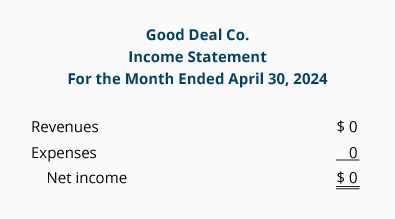
Since no supplies were used in April, there is no Supplies Expense. The $150 will be reported on the balance sheet in the asset account Supplies.
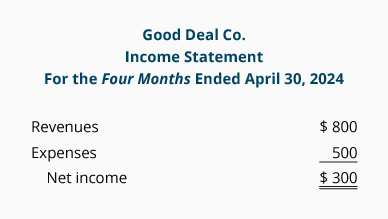
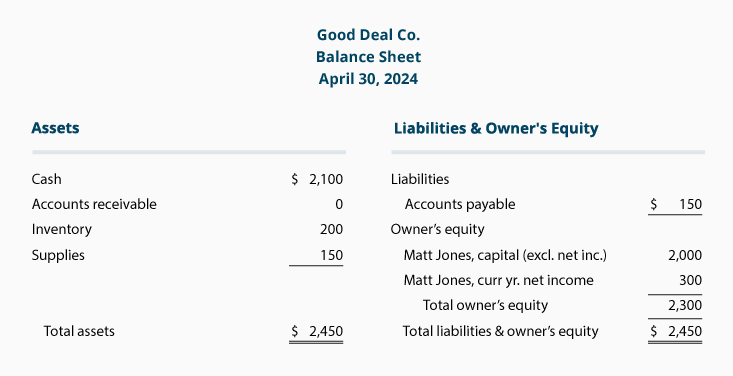
The balance sheet now includes $150 for the asset supplies and $150 for the liability accounts payable.
A balance sheet comparing April 30 amounts to March 31 amounts and the resulting differences or changes is shown here:
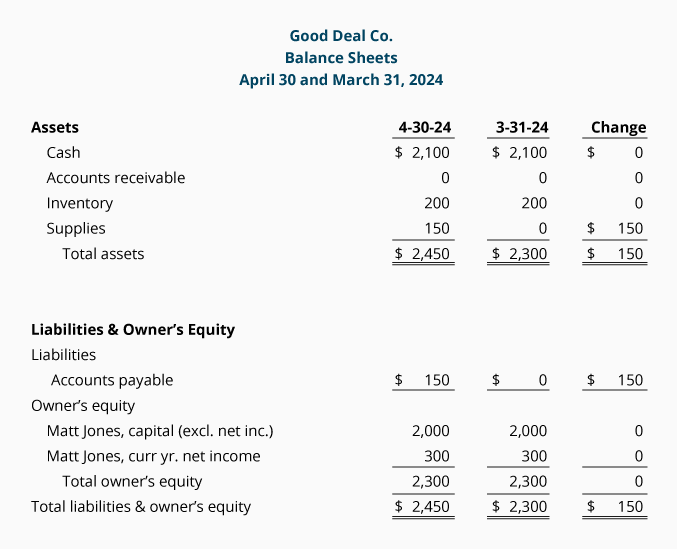
The changes that occured during the month of April will be used to prepare the SCF for the month of April.
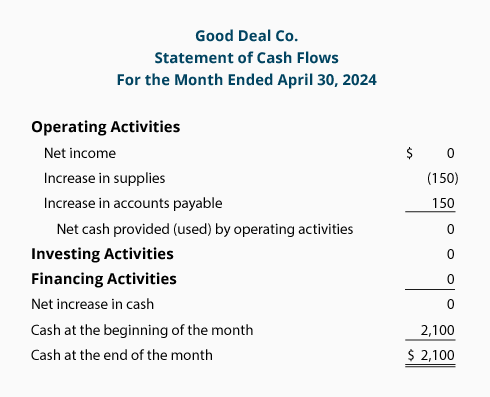
The cash flow statement for the month of April reports that there was no change in the Cash account from March 31 through April 30. The operating activities section reports the increase in Supplies and the resulting negative adjustment to the amount of net income. It also reports the increase in Accounts Payable and the resulting positive adjustment to the amount of net income.
Here's a Tip
On the statement of cash flows, think of the positive amounts (the numbers not in parentheses) as good for the company's cash balance. For example, if the company doesn't pay its bills, that's good for the company's cash balance (but bad for the liability Accounts Payable which increases).
Think of the negative amounts (the numbers within parentheses) as not good for cash. For example, if a company pays a bill, that's not good for its cash balance (but good for the liability Accounts Payable which decreases).
The following comparative balance sheet shows the changes between December 31, 2019 and April 30, 2020:
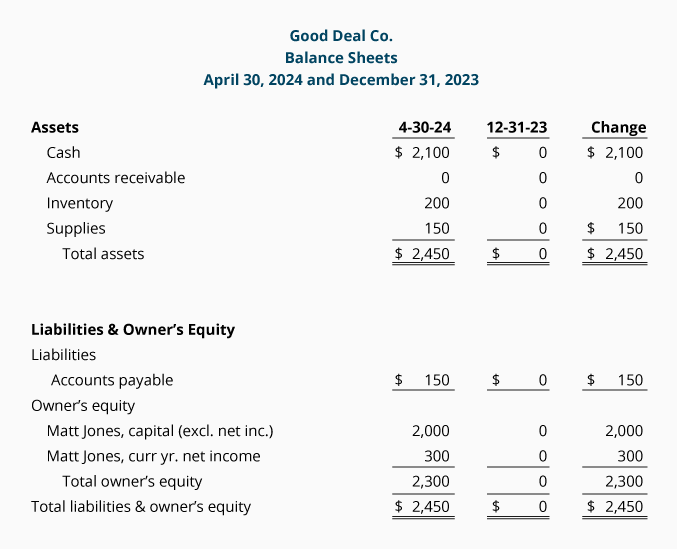
The changes will be used to prepare the SCF for the four months ended April 30.
The SCF for the period of January 1 through April 30 is:
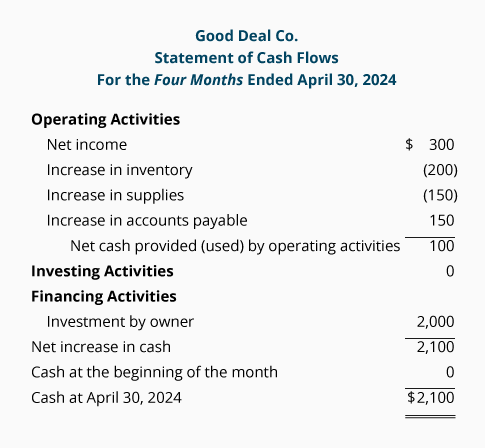
Let's review the statement of cash flows for the four months ended April 30:
The operating activities section of the SCF starts with the net income of $300 that was earned during the four-month period. The increase in inventory was not good for cash, as shown by the negative adjustment of $200. Similarly, increasing the amount of supplies on hand was not good for cash and it is reported as a negative $150. The increase in accounts payable was good for the cash balance (since some bills were not paid); therefore, the increase in accounts payable appears as a positive $150. Combining the amounts, the net change in cash that is explained by operating activities is a positive $100.
There were no changes in long-term assets. As a result, no amount is shown for investing activities.
There were no changes in short-term loans payable or long-term liabilities. However, there was a change in owner's equity since December 31. As a result, the financing activities section reports the owner's $2,000 investment in Good Deal Co. as a positive amount.
Combining the amounts in operating, investing, and financing activities, the cash flow statement reports an increase in cash of $2,100. This agrees with the change in the balance sheet's Cash from $0 on December 31, 2019 to $2,100 on April 30, 2020.
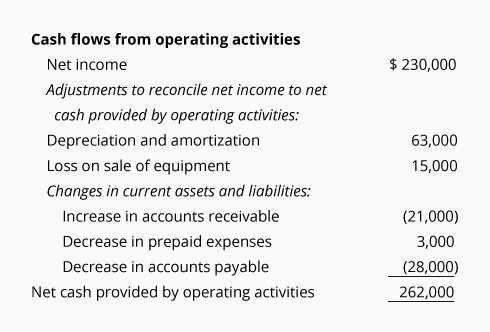



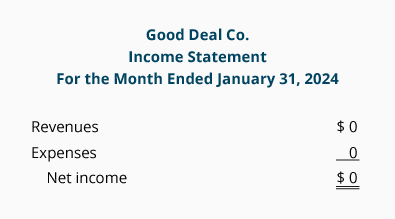
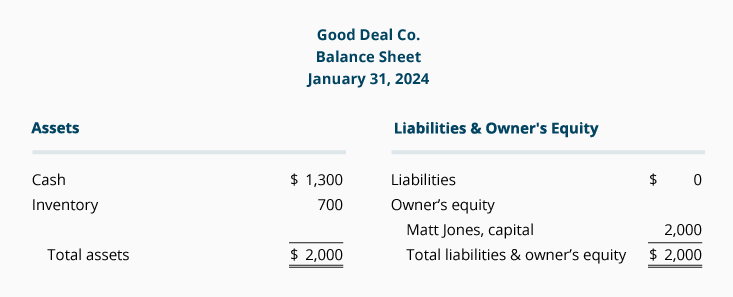
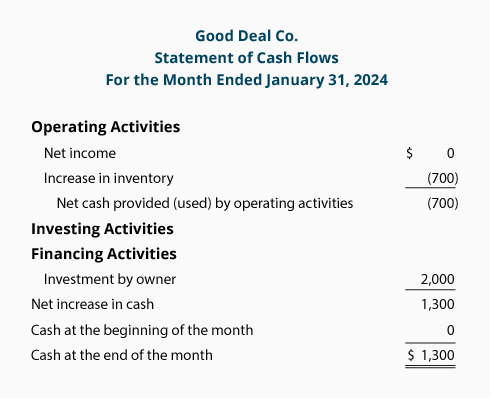
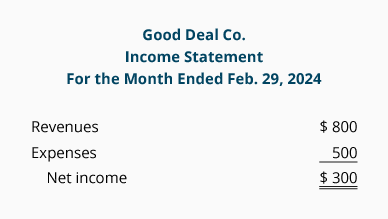
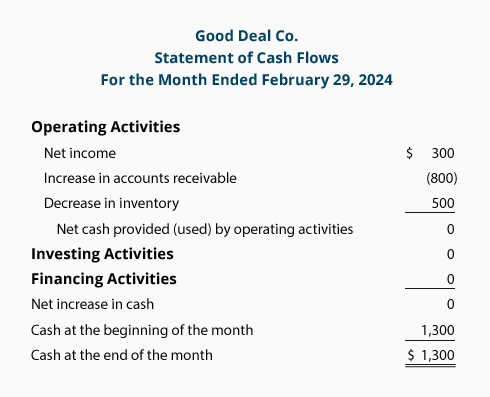
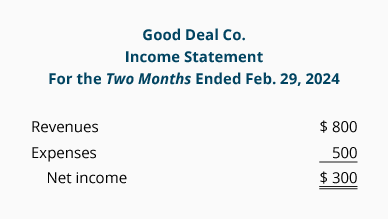
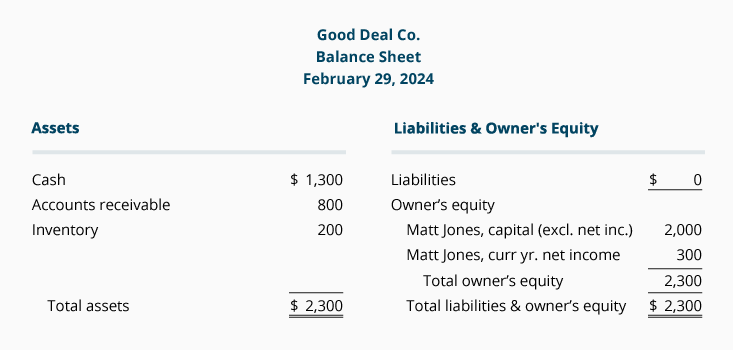
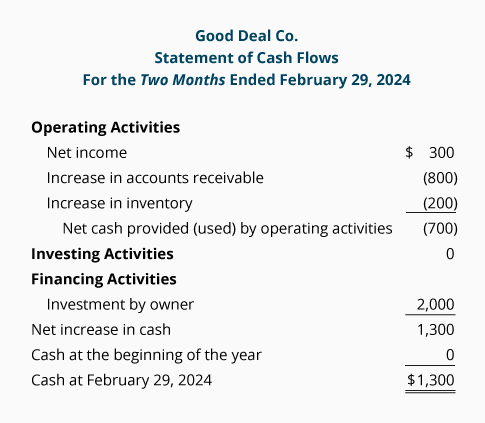
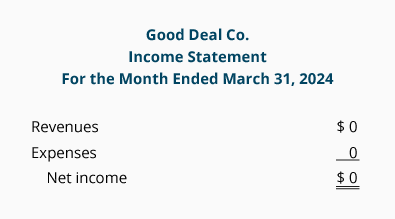
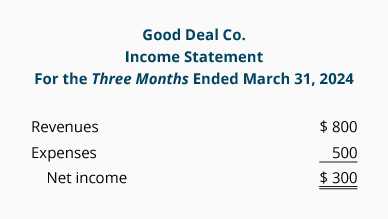
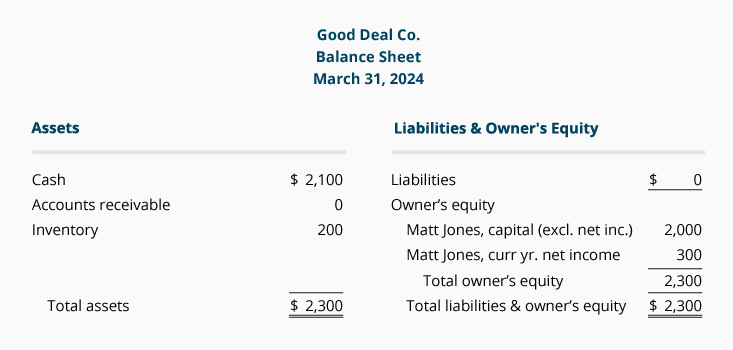
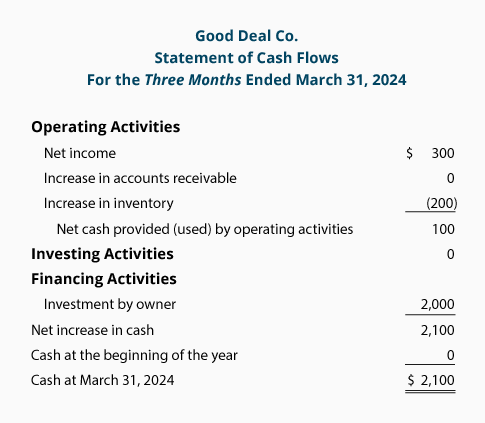
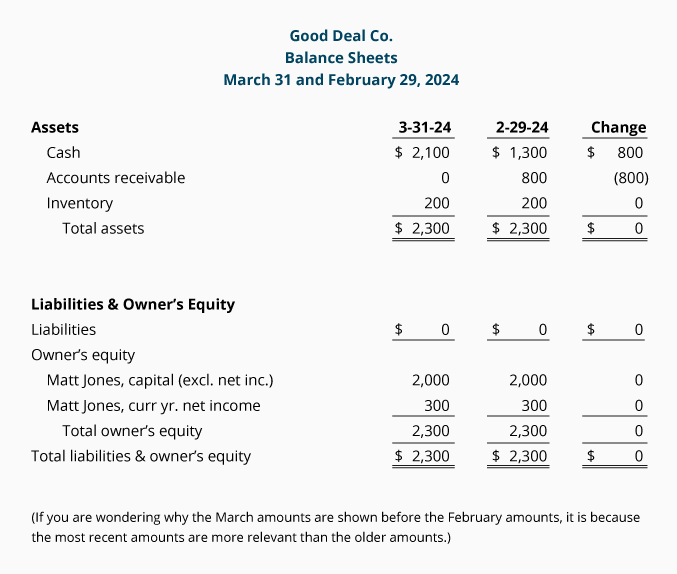
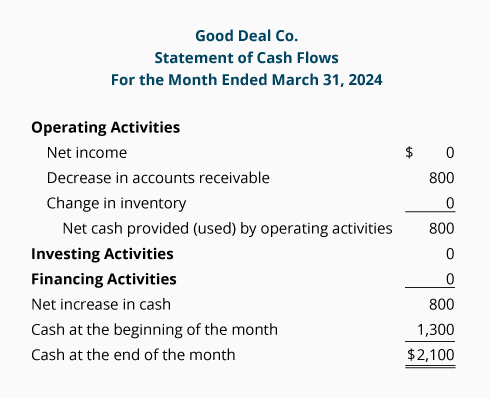

What information does the cash flow statement provide? (by Gisela Vargas)
ReplyDeleteThe amounts on the SCF provide the reasons for the change in a company's cash and cash equivalents during the period covered.
DeleteBy: Damaris Alvites
This comment has been removed by the author.
ReplyDeleteWhat are the five financial statements and the notes to the financial statements?
ReplyDeleteFiorela Mendez
Income statement
DeleteStatement of comprehensive income
Balance sheet
Statement of stockholders' equity
Statement of cash flows
Notes to the financial statements By Widman
.Income statement
Delete.Statement of comprehensive income
.Balance sheet
.Statement of stockholders' equity
.Statement of cash flows
.Notes to the financial statements
by: cristian calle
How are cash flow activities classified? By: Magdiel
ReplyDeleteOperating activities.
DeleteInvestment activities.
Financing activities.
By. Noli Cubas
What does the SCF report? By Widman
ReplyDeletethe SCF reports the inflows and outflows of cash that occurred during the same time interval as the income statement. by giovany castillo
DeleteReports the cash inflows and outflows that occurred during the same time interval as the income statement.
Delete(Fiorela Mendez)
Income statement
ReplyDeleteStatement of comprehensive income
Balance sheet
Statement of stockholders' equity
Statement of cash flows
Notes to the financial statements
What is the cash flow statement necessary for? by giovany castillo
ReplyDeleteThe cash flow statement is required for a complete set of financial statements. by juanita tocas
DeleteThe cash flow statement is important, because it allows the company and the user of financial information to know how cash and its equivalents are generated and used. By: Magdiel
DeleteStatement of income.
ReplyDeleteStatement of changes in Equity.
Statement of financial position
Statement of cash flows
notes to financial statements (by: Gisela Vargas)
What does not report the income statement?
ReplyDeleteBY: FARID PINEDO
Cash collected from sales. (The cash might be collected from customers 45 days after the sale.)
DeleteCash paid for goods sold. (Payment may have been made many months prior to their sale.)
Cash paid for buildings and equipment that will be expensed over the next 5 to 30 years.
Cash received from the sale of long-term assets
Cash received from bank loans
Cash payments to reduce a loan's principal balance
Cash withdrawn by owners or cash dividends paid to stockholders
:V
Does not report the following:
Delete* Cash collected from sales. (Cash can be collected from customers 45 days after sale.)
* Cash paid for goods sold. (Payment may have been made many months prior to sale.)
* Cash paid for buildings and equipment that will be expensed for the next 5 to 30 years.
* Cash received from the sale of long-term assets.
* Cash received from bank loans.
* Cash payments to reduce the principal balance of a loan.
* Cash withdrawn by owners or cash dividends paid to shareholders.
By: Jose rafael
- Cash collected from sales. (The cash might be collected from customers 45 days after the sale.)
Delete- Cash paid for goods sold. (Payment may have been made many months prior to their sale.)
- Cash paid for buildings and equipment that will be expensed over the next 5 to 30 years.
- Cash received from the sale of long-term assets.
- Cash received from bank loans.
- Cash payments to reduce a loan's principal balance.
- Cash withdrawn by owners or cash dividends paid to stockholders.
by: DEANELLI JULCA
This comment has been removed by the author.
ReplyDeleteThis comment has been removed by the author.
ReplyDeleteIncome statement
ReplyDeleteStatement of comprehensive income
Balance sheet
Statement of stockholders' equity
Statement of cash flows
Notes to the financial statements
BY: FARID PINEDO
This comment has been removed by the author.
ReplyDeleteWhat disadvantages of information does the income statement have?
ReplyDeleteby: Ary Ganoza
Who report the cash flow statement?
ReplyDeleteby: Paola Aguilar
what is not report in the income statement?
ReplyDeleteby juanita tocas
What is a cash flow statement necessary for?
ReplyDeleteBecause through the cash flow statement all the cash in a company is controlled, it also allows to quickly know its liquidity. By keisy López
Delete
DeleteThe statement of cash flows reflects the liquidity of the company and, therefore, helps to determine its viability in the short term.
by: Felix
Income statement
ReplyDeleteStatement of comprehensive income
Balance sheet
Statement of stockholders' equity
Statement of cash flows
Notes to the financial statements by jeff echevarria
What are the 3 sections of the SCF?
ReplyDeleteBy: Damaris Alvites
What are the subtitles of the three sections of the SCF? by jeff echevarria
ReplyDeleteWhat is the cash flow statement necessary for? By. Noli Cubas
ReplyDeleteWhat are the complete set of financial statements? By: Jose rafael
ReplyDeleteStatement of income
ReplyDeleteStatement of comprehensive income
Balance sheet
Stockholders' equity statement
Statement of cash flows
Notes to the financial statements
BY: Paola Aguilar
Explains the important function of a cash flow statement in companies:
ReplyDeleteby Keisy Mylene López Vásquez
What provide the amounts on the SCF? by: cristian calle
ReplyDeletehow many are the financial statements and mention them.
ReplyDeletebu: nicolle viena.
They are 5:
DeleteEstado de resultados
Estado de resultado integral
Balance general
Estado de capital contable
Estado de flujos de efectivo
Notas a los estados financieros
By : Lily Carrasco
There are five financial statements and one notes to the financial statements.
DeleteThe five financial statements are:
- Income statement
- Statement of comprehensive income
- Balance sheet
- Statement of stockholders' equity
- Statement of cash flows
They are 5:
DeleteEstado de resultados
Estado de resultado integral
Balance general
Estado de capital contable
Estado de flujos de efectivo
Notas a los estados financieros
By: Frank Tantarico
By: Alessandro Gomez
DeleteThey're five financial statements
- Income statement
- Statement of comprehensive income
- Balance Sheet
- Statement of stockholders' equity
- Statement of cash flows
ReplyDeleteWhat is the cash flow statement for? By Lily Carrasco
It serves as an indicator of the liquidity of the company, that is, of it's ability to generate cash.
DeleteBy: Ruth Cristina
What are the tree " Basic types of cash flow activities?
ReplyDeleteBy: Ruth Cristina
what does (GAAP) mean in accounting? by Deanelli Julca
ReplyDeleteWhat is not reported in the income statement? By Yeni Perez
ReplyDelete
ReplyDeleteWhat can be seen in the Statement of Equity?
by: Felix
What states are required to have a clear vision of sales and comoros?
ReplyDeleteBy Rocio Sanchez
What are the complete set of financial statements? Linda Gutarra
ReplyDeleteWHAT ARE THE OPERATIONAL ACTIVITIES? MERLI COTRINA
ReplyDeleteWHAT IS THE DIFFERENCE BETWEEN CASH FLOW AND EARNINGS?
ReplyDeleteby: Alonso Saboya
What Examples of investment activities do you know?
ReplyDeleteBy: Frank Tantarico
By: Alessandro Gomez
ReplyDeleteExplains the important function of a cash flow statement in company?